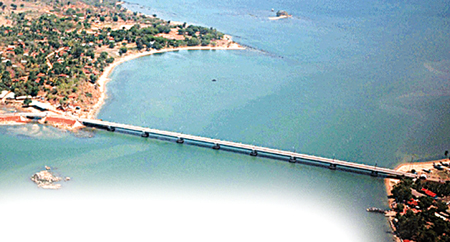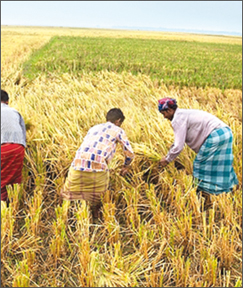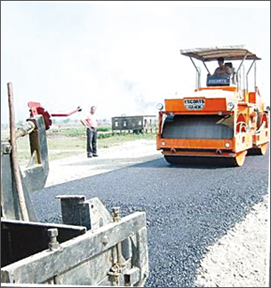|
Govt policies pay dividends :
Economy, industries on sound footing
by Shirajiv Sirimane
|

Sri Lanka’s longest bridge at Kinniya
|
Sri Lanka is a country with an agro-based economy though most exports
in this sector are not among the top earners. With the introduction of
the open economy in 1977 the apparel sector received a major boost and
overtook agro exports and reached the top slot in exports as the focus
on agriculture was lost. However, the present government realised the
importance of the agriculture sector and the major positive impact it
would have on the rural economy and granted several benefits and
concessions which are now helping the sector in a big way.
One of the major problems the agriculture sector faced was the high
price farmers had to pay for fertiliser. The Mahinda Chinthana had
promised a fertiliser subsidy and the government fulfilled this promise
by providing farmers with a Rs. 350 subsidy.
One of the other major setbacks the farming community had to face was
a certified price for paddy. This year the Minister of Agriculture
Maithripala Sirisena introduced a new mechanism to purchase paddy at a
guaranteed price.
With the economic centres being set up under an initiative of
Minister of Trade and Commerce Bandula Gunawardane, locally produced
fruits and vegetables are yielding high prices for farmers. The Minister
has also taken steps not to import food items such as onions and
potatoes during the harvesting season, thus guaranteeing a high price
for the local farmer and also ensuring a checks and balances system for
the customer.
Mega rural irrigation projects too have got off the ground not only
in the South, but in the North and the East as well, prompting farmers
to cultivate abandoned land in these areas.

Paddy harvesting |

Highway development |
 |
| Garment
workers |
The transport and fishing restrictions in the North and the East have
been fully lifted, enabling the North and East produce to hit the
Colombo market for the first time after 30 years. With a lucrative
market open for the North and East products, the farmer is now looking
at better times ahead.
The incentives provided by the government to the cultivation of the
cash crops tea, rubber and coconut are once again on the rise while the
fertiliser subsidy offered to them is having a major positive impact.
Sri Lanka ending the 30-year-old conflict with a humanitarian touch
has somewhat angered the West and Sri Lanka is being given minor pinches
by the Western diplomacy. This has also put a check on the GSP Plus
facility that was offered to Sri Lanka.
However, though the Opposition expected the economy of the country to
crash and the apparel sector to become something of the past, the
industry is surviving. Both the government and the Central Bank Governor
have assured that concessions would be provided to the industry if the
GSP Plus facility is withdrawn.
The favourable foreign relations maintained by the government are
also yielding rich benefits with all the major mega development programs
receiving foreign aid. Projects such as the Hambantota Harbour, Upper
Kotmale and Norochcholai power projects and Colombo South Harbour
Development which were stalled due to lack of finances have now got off
the ground.
Industrial development
Industrial development in Sri Lanka has shown a vast improvement
during the last four years. Earnings from the apparel industry, which
was Rs. 291 billion in 2005, increased to Rs. 376 billion in 2008.
Similarly, industrial exports which were Rs. 497 billion in 2005,
increased to Rs. 667 billion in 2008.
Sri Lanka’s foreign reserves and foreign aid have reached an
unprecedented level, underlining the sound economic management policies
of the government with foreign reserves standing at six billion US
Dollars.
Foreign aid from China, India, Japan and Korea as well as the Asian
Development Bank has resulted in a very large amount of foreign exchange
to the country with China providing US$488 million in aid, India US$145
million, Japan US$311 million, and ADB US$283 million. The World Bank
has given US$202 million in aid while the Export Import Bank has given
US$40 million for the development of roads in the Hatton-Nuwara Eliya
regions. Foreign revenue has increased by US$ 3.3 billion to be on par
with the previous year which recorded an increase of US$ 2.9 billion.
Sri Lanka has over 1.8 million expatriate workers. Most are employed in
Middle Eastern countries as domestic aids and the government for the
first time also opened new employment opportunities to countries such as
Korea.
The government is also not curtailing handouts provided to the needy.
Presently the government spends Rs. 798 million per month on Samurdhi
recipients.
The government hopes to increase the payments to each Samurdhi
recipient to a minimum of Rs. 1,000 at the next budget.
The government’s aim is to provide every household with electricity
by 2012 and this would become a reality with major electricity projects
such as Upper Kotmale, Norochcholai, Kerawalapitiya and Sampur now in
the pipeline.
Sri Lanka was also elevated to middle income generating country
status recently. Sri Lanka is also pushing to double its GDP per capita
to around US$ 4,000 by 2014. According to the Central Bank, a banking
sector asset base of nearly US$ 25 to 30 billion will be required to
support this growth. Sri Lanka’s economy is expected to grow by seven
percent this year while the per capita income will rise to US$ 4,000
within the next five years due to growth in manufacturing, construction,
infrastructure facilities and tourism sector.
The government will revive the major industries of the Northern
Province such as cement, salt and mineral sands which were not operating
during periods rife with LTTE terror. The Tamil Diaspora too is expected
to invest in the island and Sri Lanka is looking at a record one billion
US dollar investments by the end of this year.
New York Times and the National Geographic channel have given
accolades to Sri Lanka stating that it’s one of the best destinations to
visit.
This would be an additional feather in the cap of Sri Lanka’s tourism
which has totally recovered and is on its way to become the number one
foreign exchange earner for Sri Lanka.
New hotels are coming up and most importantly, Sri Lanka is changing
its perception as a destination for high spending upmarket clientele.
The best compliment to Sri Lanka’s economy was given by the
International Monetary Fund Mission Leader Dr. Brian Aitken when he said
that the overall economic conditions of the country are improving as
expected.
The new road and rail network with expressways to the Matara Airport
and Kandy, new airports, five new harbours, focused development in the
North, other infrastructure provided by the government and prudent
economic management are definitely leading the country toward being the
Wonder of Asia. |

